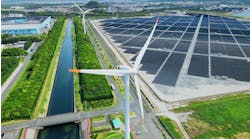To demonstrate how the U.S. will lead by example in tackling the world’s climate crisis, President Biden signed an executive order in December 2021 that reduces emissions across federal operations, invests in clean energy, and aims to create clean, healthy, and resilient communities. One of the goals outlined in the order is for the federal government portfolio of more than 300,000 buildings to reach net-zero emissions by 2045, including a 50% reduction in building emissions by 2032. The administration will also implement the first-ever Federal Building Performance Standard.
To achieve this ambitious goal, new construction and major renovations of all federal properties will increase water and energy efficiency, reduce waste, electrify systems, and promote sustainable locations. Efforts are already underway. This year, the Department of the Treasury will have completed the majority of its energy infrastructure improvements at an Internal Revenue Service Center outside of New York City through a 17-year, $30.9 million energy savings performance contract. In 2023, the Department of Transportation will complete its Volpe Transportation Center project that consolidates six buildings into a low-emissions facility with rooftop solar, zero-emission vehicle (ZEV) charging stations for all vehicles, green and cool roof technologies, a rainwater reclamation and reuse system, and a climate-resilient above-grade data center.
It's all about the data
As the federal government moves forward with this initiative, there’s no doubt that smart building technologies will play an integral role in achieving net-zero emissions across the portfolio. Nobody knows that more than Lawrence Melton, founder and CEO of The Building People who was previously responsible for more than 350 million square feet of federal real estate and implementing the largest smart buildings program in the country. Today, Melton’s company works to help multiple federal clients integrate technology to operate more efficiently and achieve energy sustainability.
“While some of the goals in the latest executive order are tough to meet, they are analogous to ESG goals that nearly every Fortune 500 company has today,” says Melton. “There is large backlog of deferred maintenance across government facilities, limited funding, and a massive portfolio where the average age of buildings is about 35 years old. If ever we had a time to get creative, now is the time.”
Some ways that The Building People get creative is to first look for efficiency opportunities within existing systems and prioritize efforts based on the largest energy consumers. “Funding is not necessarily a limit. Our go-to market strategy is to leverage existing systems, deploy advanced metering and submetering to collect real-time data from hundreds of federal facilities tied into a national network, and then analyze that data. Through technologies like AI, we can then operationalize efficiency, automate emissions reduction, and make decisions on investments to achieve net-zero,” says Trevor Morrison, vice president of energy, smart buildings and sustainability services for the company. “We also focus on energy-intensive systems like chillers and mechanical plants, and often the measures we take to reduce energy use on those systems also help reduce water usage, which is another key part of the executive order.”
While deploying advanced metering and submetering on power systems throughout federal buildings will be vital, Cisco points out that technologies like Power over Ethernet provide even more granular data on power usage. “There’s only so much information you can get when metering on a building or floor level,” says Bob Cicero, Americas smart building leader at Cisco. “By connecting OT and IT devices to the network and powering them with digital power like PoE, we can get very granular power consumption information down to the device level.”
Power delivery will change
Another ambitious goal in the latest executive order is to achieve 100% carbon pollution-free electricity by 2030, at least half of which will be locally supplied clean energy to meet 24/7 demand. The federal government will work with utilities, developers, technology firms, financiers, and others to purchase electricity produced from resources that generate no carbon emissions, including solar and wind. Again, these efforts are already underway.
In 2022, the Department of Defense’s (DOD) Edwards Air Force Base in California will add 520 MW of carbon-free electricity to the grid by completing one of the country’s largest solar photovoltaic (PV) array projects. Also in 2022, DOD’s Pacific Missile Range Facility in Hawaii will complete construction of the nation’s largest 100% clean energy microgrid that leverages a 14-MW solar facility paired with a 70-MWh battery energy storage system that allows the facility to become self-sufficient in the event of a loss of transmission feed from the grid.
Digital power technologies like DC microgrids have long been on the federal government’s radar and have been tested extensively in facilities like the U.S. Department of Energy’s (DOE) Pacific Northwest National Laboratory. “Nobody has installed more DC microgrids that the U.S. Army, and these investments are considered the crown jewel,” says Morrison. “There are a number of test beds that only exist in the federal space, and they have the labs and programs to validate these types of technologies.”
Cisco’s Cicero points out that DC power delivery into and throughout the building is an ideal way for the federal government to also achieve energy consumption goals. “Whenever we’re deploying solar or wind that generates DC power, or even emerging micro power sources like window film that generates power, we’re typically converting it to AC and then back to DC for many of the everyday devices we see around the office—laptops, LED lights, cell phones—and that conversion creates significant energy losses,” he says. “With a DC microgrid, we may need to step down power to lower levels, but it’s still going to be much more efficient than AC power. That’s why a lot is pivoting to DC power, including how Cisco network switches are powered.”
Some nuances to consider
While most companies that supply both the private and public sectors see President Biden’s executive order as an opportunity as they proceed with business as usual, providing smart building technologies to the federal government involves some nuances that can’t be ignored.
“The main difference between the private sector and the federal government is that there’s a higher security threshold in how hardware and software is remediated, and these federal portfolios are accomplishing some of the most forward-looking initiatives within a cybersecurity lens,” says Morrison.
Cisco’s Cicero agrees. “In the federal space, security is a huge focus. We’ve made significant investments in cybersecurity that looks at operational devices and protocols to understand where there are threats and take measure to protect them,” he says. “Segmentation and categorizing devices based on their application, where they are located, and what access they should have are also key to ensuring security.”
For those wondering if executive orders like this and others from the Biden administration will change with new administrations, Melton points out that executive orders come with every administration, and most stay in play. “Some of the most aggressive goals that we’re still continuing to meet were implemented by George W. Bush in his 2007 executive order 13423 that required federal buildings to reduce energy consumption by 30%,” says Melton. “While directives may be adjusted over time based on innovation and global issues, energy reduction goals are here to stay, and we support the narrative that the federal government will be a leader.”
Betsy Conroy is a freelance writer, editor, and content consultant, specializing in business-to-business media and commerce. She has 30 years’ experience writing technical content.



